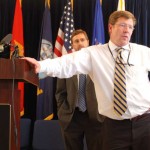Legacies of Lincoln
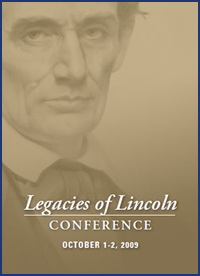 The Legacies of Lincoln Conference, a joint undertaking of the Law School and the Department of History, was an impressive event last week. It began on Thursday evening, with Allen Guelzo, Gettysburg College’s renowned Lincoln historian, delivering the History Department’s annual Klement Lecture. There then followed on Friday three panels, variously addressing “Lincoln and Politics,” “Lincoln and the Constitution,” and “Lincoln as Lawyer,” and respectively led by Heather Cox Richardson of the University of Massachusetts-Amherst, Michael Les Benedict of The Ohio State University, and Mark E. Steiner of the South Texas College of Law. The other panelists were James Marten and Alison Clark Efford of Marquette’s History Department (politics panel), Stephen Kantrowitz of the University of Wisconsin-Madison and Kate Masur of Northwestern University (Constitution panel), and two of our part-time faculty (for the Lincoln-as-lawyer panel): Joseph S. Ranney, III, of Dewitt Ross & Stevens and Thomas L. Shriner, Jr., or Foley & Lardner. Audio of the three panels is available on the Law School’s webcast page. A number of the participants will permit the Law School to publish papers reflecting their remarks, and I expect that, as the different papers are ready over the course of the time to come, Dan Blinka or I will use this blog to share them with interested readers. A special thanks to Jim Marten and to Dan Blinka for their roles in putting this conference together.
The Legacies of Lincoln Conference, a joint undertaking of the Law School and the Department of History, was an impressive event last week. It began on Thursday evening, with Allen Guelzo, Gettysburg College’s renowned Lincoln historian, delivering the History Department’s annual Klement Lecture. There then followed on Friday three panels, variously addressing “Lincoln and Politics,” “Lincoln and the Constitution,” and “Lincoln as Lawyer,” and respectively led by Heather Cox Richardson of the University of Massachusetts-Amherst, Michael Les Benedict of The Ohio State University, and Mark E. Steiner of the South Texas College of Law. The other panelists were James Marten and Alison Clark Efford of Marquette’s History Department (politics panel), Stephen Kantrowitz of the University of Wisconsin-Madison and Kate Masur of Northwestern University (Constitution panel), and two of our part-time faculty (for the Lincoln-as-lawyer panel): Joseph S. Ranney, III, of Dewitt Ross & Stevens and Thomas L. Shriner, Jr., or Foley & Lardner. Audio of the three panels is available on the Law School’s webcast page. A number of the participants will permit the Law School to publish papers reflecting their remarks, and I expect that, as the different papers are ready over the course of the time to come, Dan Blinka or I will use this blog to share them with interested readers. A special thanks to Jim Marten and to Dan Blinka for their roles in putting this conference together.

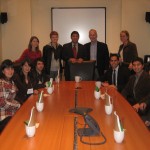 On their last day of the exchange program, October 2, the Chilean students visited an array of legal organizations working in the Milwaukee community.
On their last day of the exchange program, October 2, the Chilean students visited an array of legal organizations working in the Milwaukee community. 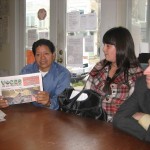 In the afternoon the students visited non-governmental agencies working with the Latino community in South Milwaukee. First, they visited Catholic Charities to learn about immigration work and the issues it raises, most notably the hardship faced by families that are often separated due to their immigrant status. Attorney Barb Graham spoke of her tireless work to represent her clients, which frequently requires travelling to Chicago. Afterwards, the students visited Centro Legal where Executive Director Heather Ramirez invited them to cookies and Alterra coffee. The meeting featured staff lawyers Sam Levin and Jason Mishelow speaking about family law; and Mike Blater, criminal law. Board member Mike Balter also offered information about the organization, which offers legal services on a sliding scale. The final stop was at Voces de la Frontera where the members of this association spoke of their grassroots movement to change policy in favor of immigrant and Latino populations, such as laws to allow for valid drivers licenses and fair wages. They explained that their legal work (free clinics on Saturday) complement their activism to help stimulate broader policy change.
In the afternoon the students visited non-governmental agencies working with the Latino community in South Milwaukee. First, they visited Catholic Charities to learn about immigration work and the issues it raises, most notably the hardship faced by families that are often separated due to their immigrant status. Attorney Barb Graham spoke of her tireless work to represent her clients, which frequently requires travelling to Chicago. Afterwards, the students visited Centro Legal where Executive Director Heather Ramirez invited them to cookies and Alterra coffee. The meeting featured staff lawyers Sam Levin and Jason Mishelow speaking about family law; and Mike Blater, criminal law. Board member Mike Balter also offered information about the organization, which offers legal services on a sliding scale. The final stop was at Voces de la Frontera where the members of this association spoke of their grassroots movement to change policy in favor of immigrant and Latino populations, such as laws to allow for valid drivers licenses and fair wages. They explained that their legal work (free clinics on Saturday) complement their activism to help stimulate broader policy change.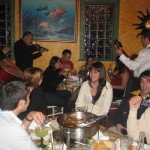 In the evening the Chilean delegation accepted the gracious invitation to attend the annual dinner of the MULS Hispanic Law Students Association which took place at Club Tres Hermanos in South Milwaukee. The festive event featured Mexican cuisine and conversation in both Spanish and English. The Chileans sang songs along with the Mariachi band and demonstrated Chilean dances. The occasion was a perfect ending to a full week of academic exploration.
In the evening the Chilean delegation accepted the gracious invitation to attend the annual dinner of the MULS Hispanic Law Students Association which took place at Club Tres Hermanos in South Milwaukee. The festive event featured Mexican cuisine and conversation in both Spanish and English. The Chileans sang songs along with the Mariachi band and demonstrated Chilean dances. The occasion was a perfect ending to a full week of academic exploration.